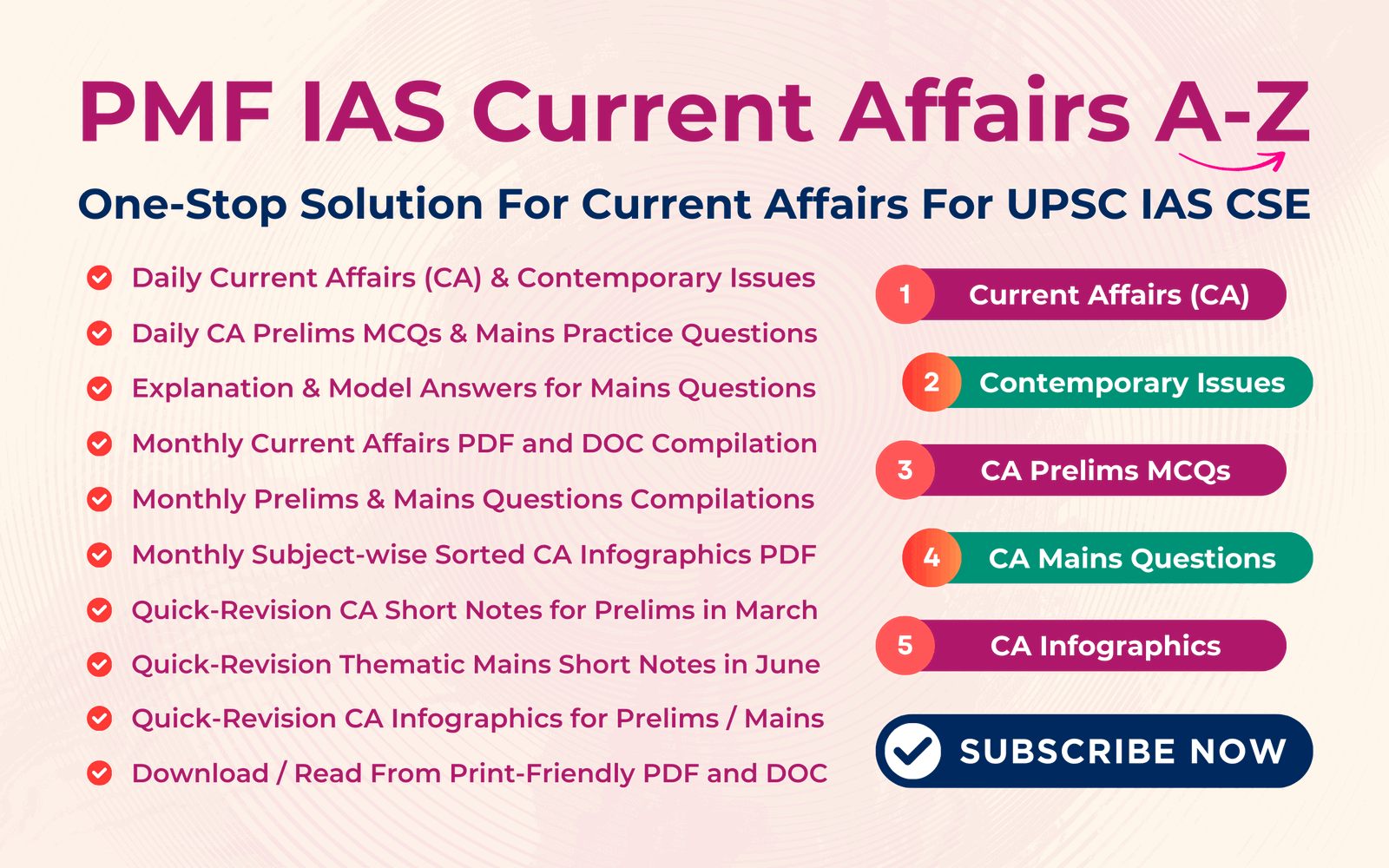
Coal | Types of Coal: Peat, Lignite, Bituminous Coal & Anthracite Coal
Subscribe to Never Miss an Important Update! Assured Discounts on New Products!
Must Join PMF IAS Telegram Channel & PMF IAS History Telegram Channel
Coal – Formation of Coal – Types of Coal – Peat, Lignite, Bituminous Coal & Anthracite Coal. Carbon content in different types of coal. Importance of each type.
Coal
- Also called black gold.
- Found in sedimentary strata [layers of soil].
- Contains carbon, volatile matter, moisture and ash [in some cases Sulphur and phosphorous]
- Mostly used for power generation and metallurgy.
- Coal reserves are six times greater than oil and petroleum reserves.
Carboniferous Coal
- Most of the world’s coal was formed in Carboniferous age [350 million years ago][Best quality coal].
- Carboniferous age: In terms of absolute time, the Carboniferous Period began approximately 358.9 million years ago and ended 298.9 million years ago. Its duration is approximately 60 million years.
- The name Carboniferous refers to coal-bearing strata.
Formation of Coal
Amount of oxygen, nitrogen and moisture content decreases with time while the proportion of carbon increases [The quantity of carbon doesn’t increase, only its proportion increases due to the loss of other elements].
Capacity of coal to give energy depends upon the percentage or carbon content [Older the coal, much more is its carbon content].
Percentage of carbon in coal depends upon the duration and intensity of heat and pressure on wood. [carbon content also depends on depth of formation. More depth == more pressure and heat == better carbon content].
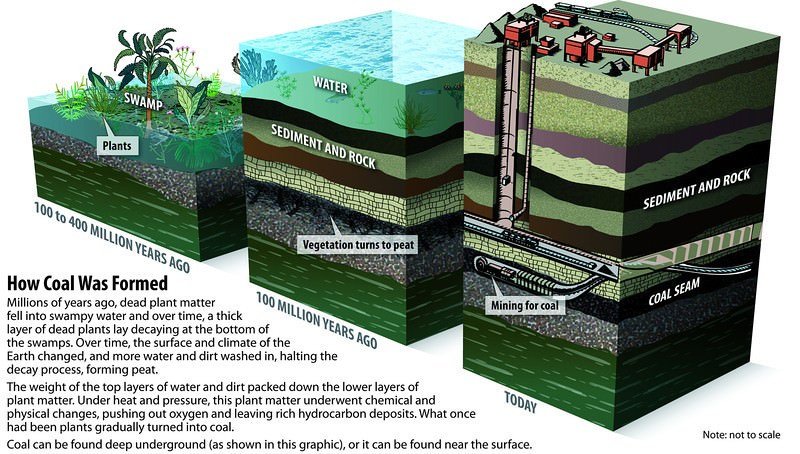
- Coal formed millions of years ago when the earth was covered with huge swampy [marshy] forests where plants – giant ferns and mosses – grew.
- As the plants grew, some died and fell into the swamp waters. New plants grew up to take their places and when these died still more grew.
- In time, there was thick layer of dead plants rotting in the swamp. The surface of the earth changed and water and dirt washed in, stopping the decaying process.
- More plants grew up, but they too died and fell, forming separate layers. After millions of years many layers had formed, one on top of the other.
- The weight of the top layers and the water and dirt packed down the lower layers of plant matter.
- Heat and pressure produced chemical and physical changes in the plant layers which forced out oxygen and left rich carbon deposits. In time, material that had been plants became coal.
- Coals are classified into three main ranks, or types: lignite, bituminous coal, and anthracite.
- These classifications are based on the amount of carbon, oxygen, and hydrogen present in the coal.
- Coals other constituents include hydrogen, oxygen, nitrogen, ash, and sulfur.
- Some of the undesirable chemical constituents include chlorine and sodium.
- In the process of transformation (coalification), peat is altered to lignite, lignite is altered to sub-bituminous, sub-bituminous coal is altered to bituminous coal, and bituminous coal is altered to anthracite.
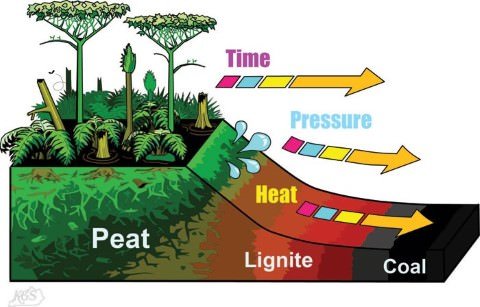
Types of Coal
- Peat, Lignite, Bituminous & Anthracite Coal.
- This division is based on carbon, ash and moisture content.
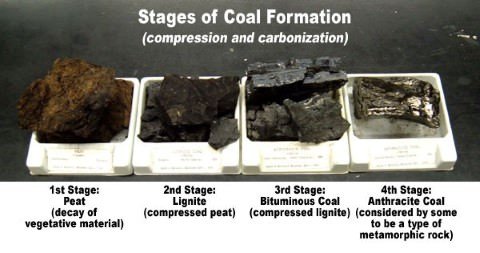
Peat
- First stage of transformation.
- Contains less than 40 to 55 per cent carbon == more impurities.
- Contains sufficient volatile matter and lot of moisture [more smoke and more pollution].
- Left to itself, it burns like wood, gives less heat, emits more smoke and leaves a lot of ash.
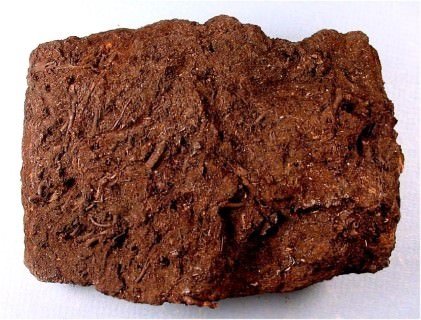
Lignite
- Brown coal.
- Lower grade coal.
- 40 to 55 per cent carbon.
- Intermediate stage.
- Dark to black brown.
- Moisture content is high (over 35 per cent).
- It undergoes SPONTANEOUS COMBUSTION [Bad. Creates fire accidents in mines]
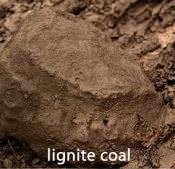
Bituminous Coal
- Soft coal; most widely available and used coal.
- Derives its name after a liquid called bitumen.
- 40 to 80 per cent carbon.
- Moisture and volatile content (15 to 40 per cent)
- Dense, compact, and is usually of black colour.
- Does not have traces of original vegetable material.
- Calorific value is very high due to high proportion of carbon and low moisture.
- Used in production of coke and gas.
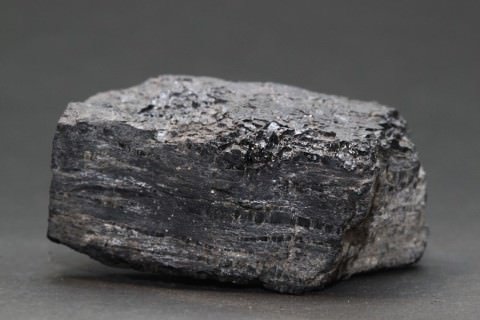
Anthracite Coal
- Best quality; hard coal.
- 80 to 95 per cent carbon.
- Very little volatile matter.
- Negligibly small proportion of moisture.
- Semi-metallic lustre.
- Ignites slowly == less loss of heat == highly efficient.
- Ignites slowly and burns with a nice short blue flame. [Complete combustion == Flame is BLUE == little or no pollutants. Example: LPG]
- In India, it is found only in Jammu and Kashmir and that too in small quantity.
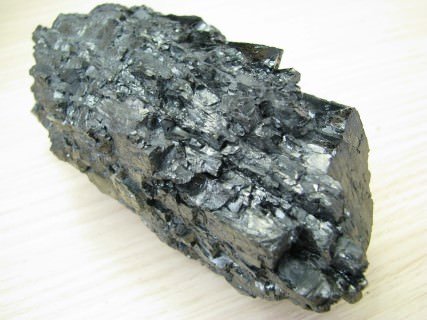
Primary References: NCERT Geography, Indian Geography by Kullar [Amazon and Flipkart]




![PMF IAS Environment for UPSC 2022-23 [paperback] PMF IAS [Nov 30, 2021]…](https://pmfias.b-cdn.net/wp-content/uploads/2024/04/pmfiasenvironmentforupsc2022-23paperbackpmfiasnov302021.jpg)














Thanks sir great work!!! keep the river of knowledge flowing…!!!
Sir in ur series of General science please make one article on all defence missiles and space missiles… its very confusing also not able to find comprehenssive coverage of it anywhere in Internet….please help me…or if you know any source then tell that…
I will give it one month before prelims
Sir,
Can u give a broad list of what topics u will cover?
Geography Full notes for GS – Gone
General Science NCERT full notes for UPSC Prelims – Biology Done, Physics Chemistry in May
Environment Notes by April End.
Current Affairs on General Science 1 month before prelims
Thanks…
Sir/Ma’am
may I please know which is the most popular coal used for metallurgy? Is it bituminous or Anthracite?
Thank you
Please tell me all information of India
And my name is urvi kochar
Class , 5
bahut badiya! it was very nice information ! Ab bas aur nahi.
Nice link
Good afternoon.
I want to buy anthracite for use in a kiln in Zambia. May I please have a contact for a mine please ?
never ! hahaha
umm.. can you please send a map in which all of these: peat, lignite, bitunimous, anthracite are located? ( POLITICAL MAP) mind you sorry for getting you in trouble